Building on a Mission: The Project Management Building, Home to the Center’s Directors – Part 6

This series of articles features the 13 unique individuals who have led NASA’s Johnson Space Center in Houston during the past 60 years and continue to lead us into the future of human space exploration. The first five installments (parts 1, 2, 3, 4, and 5) described the Project Management Building and the center’s first nine directors through 2005. This article, covering the period from 2005 to 2012, focuses on Johnson’s 10th director — Michael L. Coats — as he led the center through the retirement of the space shuttle, increased utilization of the completed International Space Station, and the start of commercial resupply missions. In addition to making high-level decisions to maintain America’s leadership in human spaceflight, the varied activities of Johnson’s center directors also include greeting astronauts after their return from space, dedicating new facilities, and meeting with local politicians, world leaders, and celebrities. For more information about the directors who led the center, please visit Johnson Space Center Directors | NASA.
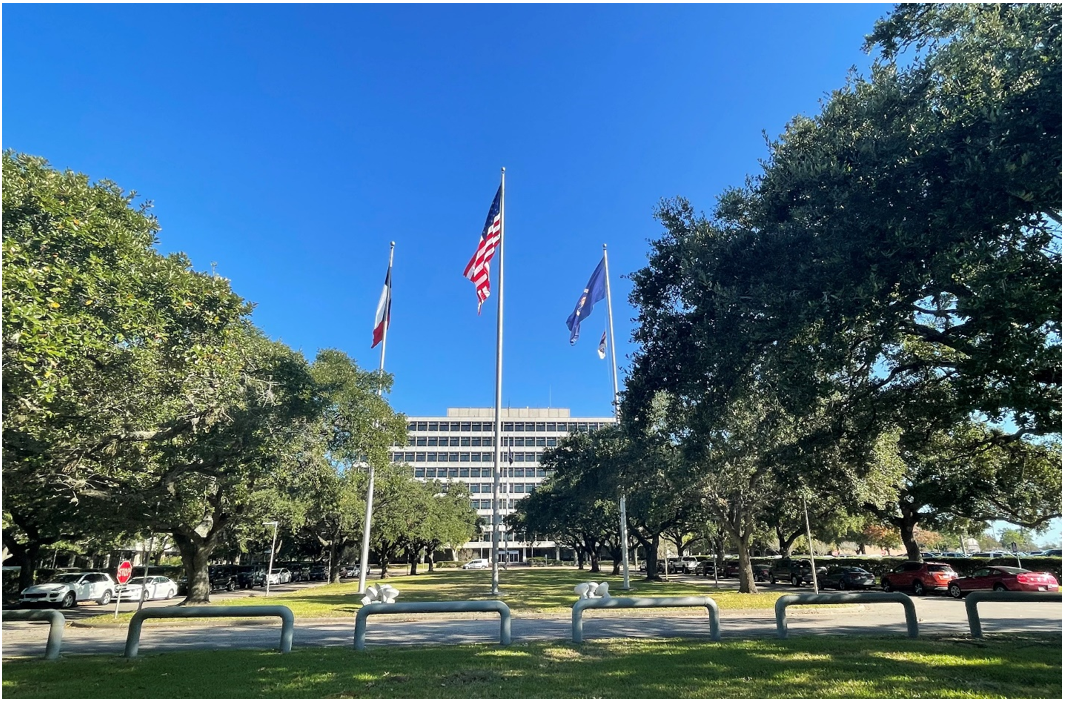
The Project Management Building, known today as Building 1, with its four flagpoles, at NASA’s Johnson Space Center in Houston in November 2021. Credits: NASA
Michael L. Coats (November 2005 to December 2012)
Michael L. Coats, a distinguished U.S. Navy aviator, first came to Johnson as one of the 35 candidates selected for the Astronaut Class of 1978 to fly aboard the new reusable space shuttle. He flew on three shuttle missions, all aboard Discovery — first as the pilot on STS-41D in 1984 and then as the commander of STS-29 in 1989 and STS-39 in 1991, logging 464 hours in space. He left NASA in 1991 to join Loral Space Information Systems in Palo Alto, California, and then assumed a position as a vice president at Lockheed Martin Space Systems in Denver, Colorado, prior to being named Johnson’s 10th director.
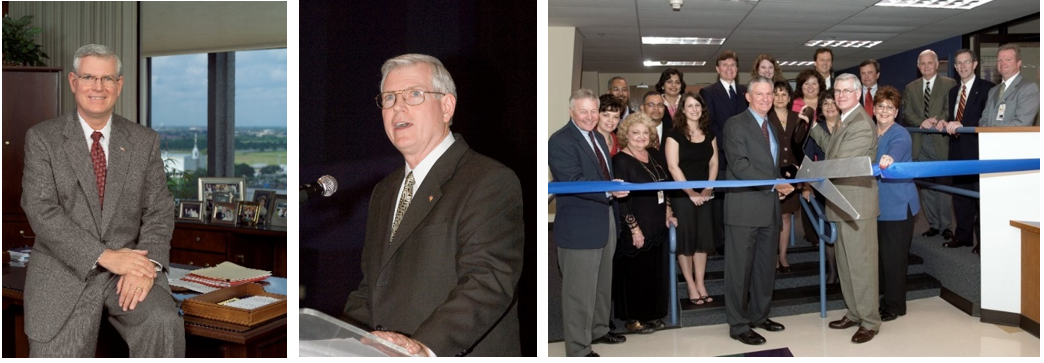
Left: Official portrait of Michael L. Coats, the 10th director of NASA’s Johnson Space Center in Houston. Middle: In November 2005, Coats speaks at Space Center Houston during an event celebrating the fifth anniversary of continuous human occupancy of the International Space Station. Right: Coats, right, with former Johnson Director Jefferson D. Howell at the ribbon cutting for the Starport Fitness Center in January 2006. Credits: NASA
On Nov. 7, 2005, NASA Administrator Michael D. Griffin named Coats as Johnson’s 10th director, succeeding Jefferson D. “Beak” Howell. Within days of taking office, Coats presided over an event at Space Center Houston to celebrate the fifth anniversary of continuous human occupancy of the International Space Station. In January 2006, former Director Howell, who began the project affectionately called “Beak’s Body Shop,” shared ribbon-cutting honors with Coats for the opening of the Starport Fitness Center, a new 7,000-square-foot state-of-the-art facility at the Gilruth Recreation Center.
Another construction effort begun by Howell culminated with the dedication on July 20, 2007, the 38th anniversary of the Apollo 11 Moon landing, of the enclosure at Johnson’s Rocket Park for the Saturn V rocket, which was restored after deteriorating while on display and open to the elements since 1979. The new building prevented any further damage to the artifact on loan to Johnson from the Smithsonian Institution.
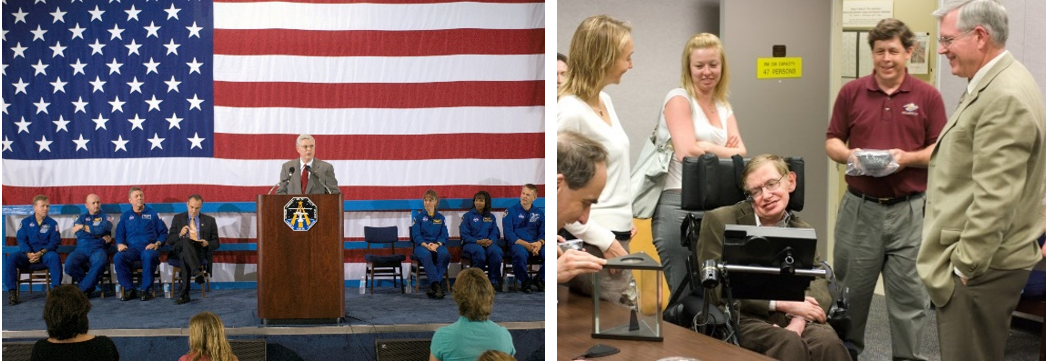
Left: In July 2006, at Ellington Field, Johnson Director Michael L. Coats addresses the audience at the welcome home ceremony for the STS-121 crew. Right: Coats, right, shows famed astrophysicist Stephen Hawking, center, a Moon rock during his April 2007 visit to the center. Credits: NASA
During his term as center director, Coats oversaw 21 space shuttle missions, beginning with STS-121, the second return-to-flight mission following the Columbia accident. That flight also returned the crew complement aboard the space station to three with the launch of Thomas A. Reiter, the first long-duration crew member from ESA (European Space Agency) aboard the facility. The remaining missions devoted their activities to completing the assembly of the space station, with the exception of STS-125, the last flight to service the Hubble Space Telescope. The final mission, STS-135, flew in July 2011, bringing to a close 30 years of space shuttle flights.
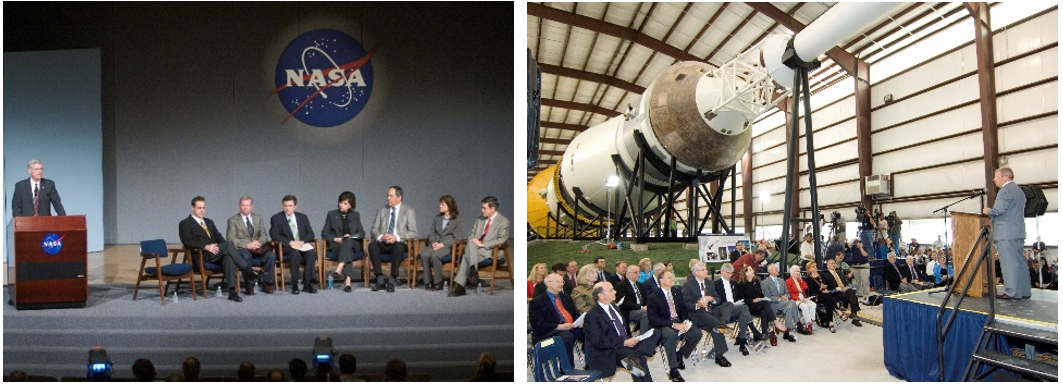
Left: In April 2007, director of NASA’s Johnson Space Center Michael L. Coats addresses employees following the on-site shooting incident. Right: Coats, seated third from left, listens to a speaker during the dedication of the Saturn V facility at Johnson’s Rocket Park in July 2007. Credits: NASA
Arguably, the three greatest challenges Coats faced while center director took place within a few months of each other in 2007. The first incident in February revolved around the relationship between two astronauts and a third individual, resulting in the dismissal of the astronauts from NASA and the U.S. Navy. The investigation into NASA’s medical and psychological screening of astronauts led to a false accusation that an astronaut had flown aboard the space shuttle while still intoxicated — a claim that turned out to be absolutely without merit. The third incident in April 2007 involved the tragic murder of a NASA employee and suicide by a disgruntled contractor employee in a Johnson facility.

Left: In October 2007, STS-120 Commander Pamela A. Melroy, left, shakes hands with Expedition 16 Commander Peggy A. Whitson, marking the first time women commanded both the space shuttle and space station. Middle: Director of NASA’s Johnson Space Center Michael L. Coats, center, watches as President George W. Bush greets Melroy at Ellington Field after her return. Right: In April 2010, the first and so far only time that the space station hosted four women at one time. Credits: NASA
The International Space Station made significant advances during Coats’ tenure as center director. During 20 space shuttle missions, astronauts completed assembly of the U.S. On-orbit Segment of the facility, a task that required 105 spacewalks to complete. Station’s crew size returned to three in 2006 and then expanded to six in 2009, greatly increasing the amount of research the crew members could accomplish. In October 2007, an historic first saw two women as commanders of both the space shuttle and the space station: Pamela A. Melroy of STS-120 and Peggy A. Whitson of Expedition 16. Melroy currently serves as NASA’s deputy administrator.
With the retirement of the space shuttle in 2011, NASA sought commercial firms to provide cargo and, ultimately, crew rotation services for the space station. The first Dragon cargo vehicle, provided by SpaceX of Hawthorne, California, arrived at the space station in May 2012. In addition, NASA signed a contract with Orbital Sciences of Dulles, Virginia, to provide cargo resupply with their Cygnus vehicles.
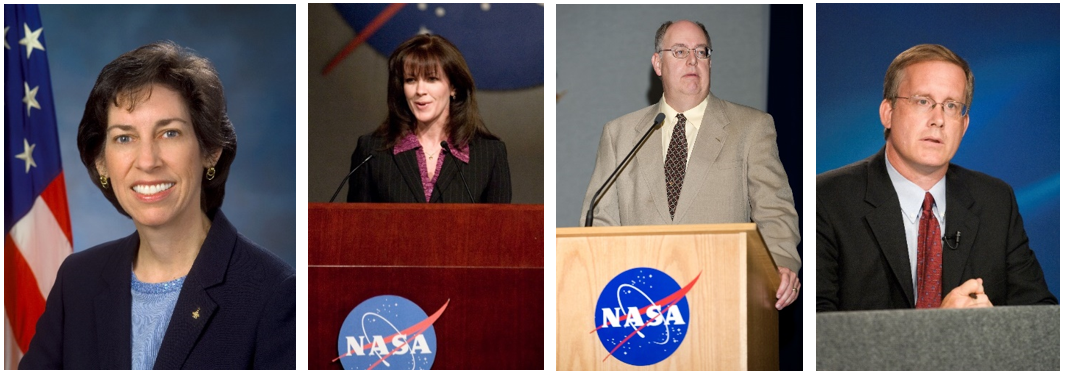
Left: Ellen L Ochoa, deputy director of NASA’s Johnson Space Center in Houston. Middle left: Director of Flight Crew Operations Janet L. Kavandi. Middle right: N. Wayne Hale, deputy associate administrator for strategic partnerships. Right: Space Shuttle Program Manager John P. Shannon. Credits: NASA
Coats made changes to the center’s management and organizations. On Sept. 19, 2007, he named Director of Flight Crew Operations Ellen L. Ochoa as the Johnson’s deputy director, succeeding Robert D. Cabana, who became director at NASA’s Stennis Space Center in Mississippi. Coats named astronaut Janet L. Kavandi to succeed Ochoa as Flight Crew Operations director. With the selection in February 2008 of Space Shuttle Program Manager N. Wayne Hale as NASA’s deputy associate administrator for strategic partnerships, NASA named John P. Shannon, Hale’s deputy and a Mission Management Team chairman, as the new program manager overseeing the space shuttle.
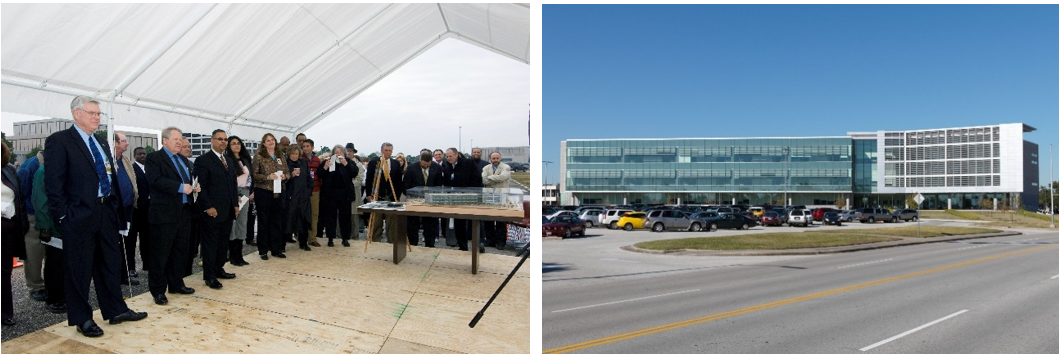
Left: In January 2008, director of NASA’s Johnson Space Center in Houston Michael L. Coats attends the ground-breaking ceremony for the center’s new Building 20. Right: Building 20 at its completion in November 2010. Credits: NASA
Coats led the center to increase energy efficiency and environmental friendliness. On March 13, 2008, he led a ribbon-cutting ceremony, attended by Houston Mayor Bill White, for the newly constructed Multi-Platform Renewable Energy System for the JSC Child Care Center. The project uses solar arrays, photovoltaic arrays, wind turbines, and a solar water heater to provide services to the Child Care Center. On Aug. 19, 2010, after an extensive renovation of the center’s Building 2, the Public Affairs Office building originally constructed in 1964, it received a Leadership in Energy and Environmental Design, or LEED, gold distinction — the second building at Johnson to be so recognized. The construction of Building 20, completed in late 2010, received a LEED platinum certification, the highest possible rating.

Left: A refresh and recharge station is set up in the Gilruth Recreation Center of NASA’s Johnson Space Center in Houston to help employees and their families in the aftermath of Hurricane Ike in September 2008. Middle: Roof damage to a Johnson building caused by Hurricane Ike. Right: Director Michael L. Coats addresses employees in the days after Hurricane Ike. Credits: NASA
The arrival of Hurricane Ike to southeast Texas in September 2008 brought widespread wind damage and flooding to the region, including the area around Johnson. Many buildings sustained damage, and many employees lost power for days or even longer — and, in some cases, their homes suffered significant damage. Coats led the center through the recovery process, including setting up a refresh and recharge station at the Gilruth Recreation Center to allow employees and their families to spend time in an air-conditioned facility and take much-needed showers. Food drives provided nourishment to those without power or cooking facilities.

Left: The astronaut class of 2009. Middle: Director of NASA’s Johnson Space Center in Houston Michael L. Coats, second from left, with U.S. Representative Sheila Jackson Lee, left, and Apollo 11 astronauts Edwin E. “Buzz” Aldrin and Neil A. Armstrong during the celebration to mark the 40th anniversary of the first Moon landing. Right: Former Johnson directors Christopher C. Kraft, left, Gerald D. Griffin, and George W.S. Abbey speak on a panel during the Apollo 11 40th anniversary celebration. Credits: NASA
The astronaut class selected in June 2009 included nine NASA candidates, as well as two from the Canadian Space Agency and three from the Japan Aerospace Exploration Agency. They comprised the first class of astronauts selected for assignment to flights to the space station and for future exploration missions. Recalling past exploration missions, Coats led the center’s activities in July 2009 to commemorate the 40th anniversary of the Apollo 11 Moon landing. Events included talks by the Apollo 11 astronauts and by former center directors Christopher C. Kraft, Gerald D. Griffin, and George W.S. Abbey about the nation’s first attempt to land humans on the Moon.
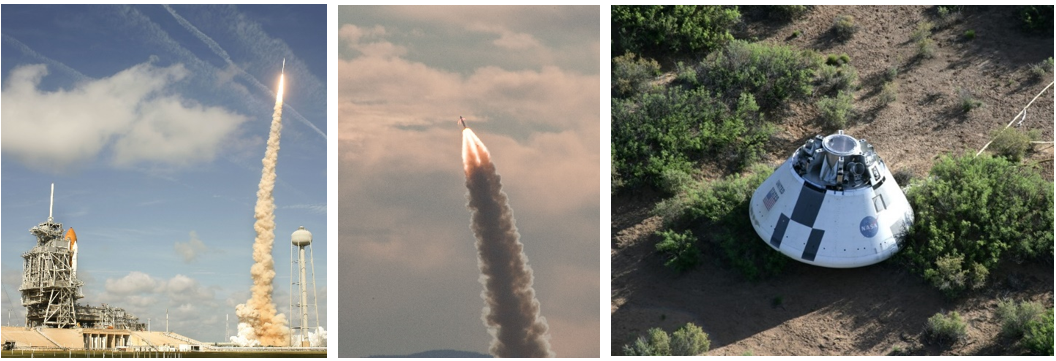
Left: In October 2009, the launch of the Ares 1-X rocket from Launch Pad 39B as Space Shuttle Atlantis sits on Pad 39A awaiting its launch on the STS-129 mission. Middle: Launch of an Orion capsule on the Pad Abort-1 (PA-1) mission from the White Sands Missile Range in New Mexico on a suborbital flight. Right: The Orion capsule after the conclusion of the PA-1 mission. Credits: NASA

Left: During a media event in October 2010, Johnson Director Michael L. Coats addresses the audience as Texas and Houston-area politicians listen. Right: In September 2011, in front of an Orion spacecraft mock-up, Coats addresses the media as NASA Administrator Charles F. Bolden, right, and Orion Program Manager Mark S. Geyer, left, listen. Credits: NASA
After President George W. Bush announced his Vision for Space Exploration in January 2004, NASA began development of the Constellation Program to accomplish the vision’s goals. Elements included the Orion Multi-Purpose Crew Vehicle (MPCV), managed beginning in 2007 by Mark S. Geyer, and the Ares family of rockets. A test launch of the Ares 1-X rocket, essentially a space shuttle Solid Rocket Booster with an upper stage simulator and an Orion spacecraft simulator, took place in October 2009 from Launch Pad 39A at NASA’s Kennedy Space Center. Incidentally, with Space Shuttle Atlantis on nearby Launch Pad 39B awaiting its launch on the STS-129 mission, this marked the last time that two rockets stood on both Launch Complex 39 pads until April 2022. While the suborbital demonstration flight met its objectives, trouble lay ahead for the Constellation Program. A blue-ribbon panel chaired by Norman Augustine concluded in its October 2009 report that the Constellation Program’s funding levels were insufficient to achieve its goals of returning astronauts to the Moon. On April 10, 2010, President Barack H. Obama proposed the cancellation of the entire Constellation Program, and Congress officially deleted it from the NASA Appropriations Bill in October. The wholesale cancellation of the program took NASA by surprise, but the agency, led by Administrator Charles F. Bolden, negotiated to have the Orion MPCV reinstated. The Space Launch System heavy-lift launcher, beginning development in 2011, replaced the Ares rockets. The Pad Abort-1 test of the Orion spacecraft took place on May 6, 2010, at the White Sands Missile Range in New Mexico and accomplished its objectives.
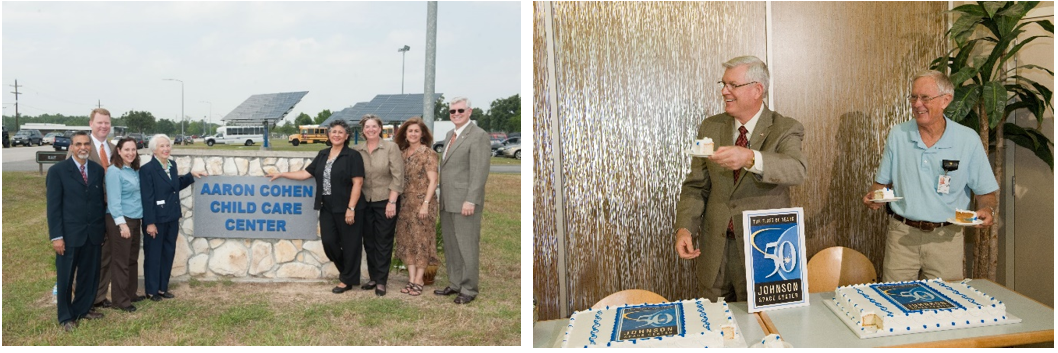
Left: In May 2010, Johnson Director Michael L. Coats, right, attends the renaming ceremony of the Child Care Center after former Center Director Aaron Cohen, whose widow, Ruth, is fourth from left. Right: In September 2011, Coats and Apollo 16 astronaut Charles M. Duke hand out cake to employees to celebrate Johnson’s 50th anniversary. Credits: NASA
In remembrance of Johnson’s past, in May 2010 Coats led a ceremony naming the Child Care Center after Aaron Cohen, Johnson’s fifth director, who established the original facility in 1989. Cohen’s widow Ruth attended the ceremonies, which also included a tree planting in the Memorial Tree Grove to honor Cohen. In September 2011, Coats helped the center to celebrate its 50th anniversary, including handing out cake to employees, ably assisted by Apollo 16 astronaut Charles M. Duke.
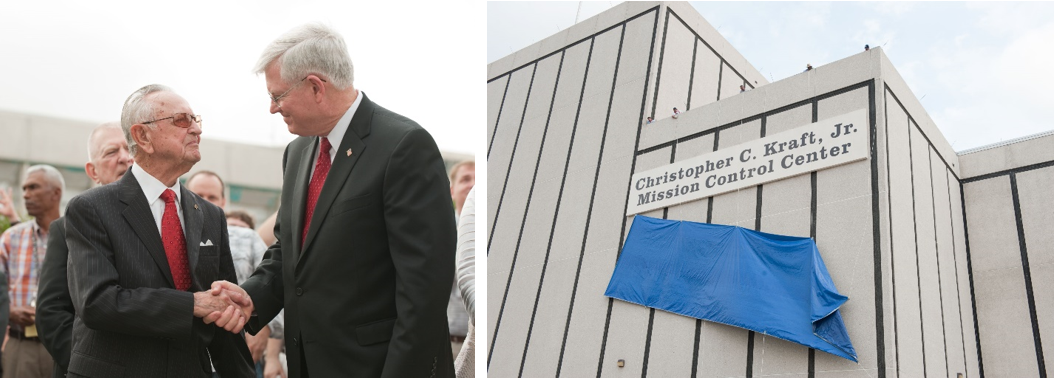
Left: In April 2011, Johnson Director Michael L. Coats, right, shakes hands with first flight director and Johnson’s second center director, Christopher C. Kraft, during the ceremony naming the Building 30 Mission Control Center after Kraft. Right: The unveiling of the sign on Building 30. Credits: NASA
The JSC community honored Christopher C. Kraft, NASA’s first flight director and the architect of mission control, who also served as Johnson’s second director from 1972 to 1982, by naming the Building 30 Mission Control Center after him. Coats led the ceremony on April 14, 2011, thanking Kraft for his decades of service to NASA and his country. Workers unveiled a sign on the building bearing Kraft’s name.

Left: In July 2011, Johnson Director Michael L. Coats, center, watches the STS-135 launch from Firing Room 4 at NASA’s Kennedy Space Center in Florida, with Kennedy Director Robert D. Cabana, right, and other senior managers. Right: At Johnson in front of the main administration building, Coats watches as the space shuttle banner is lowered for the last time following the landing of STS-135. Credits: NASA
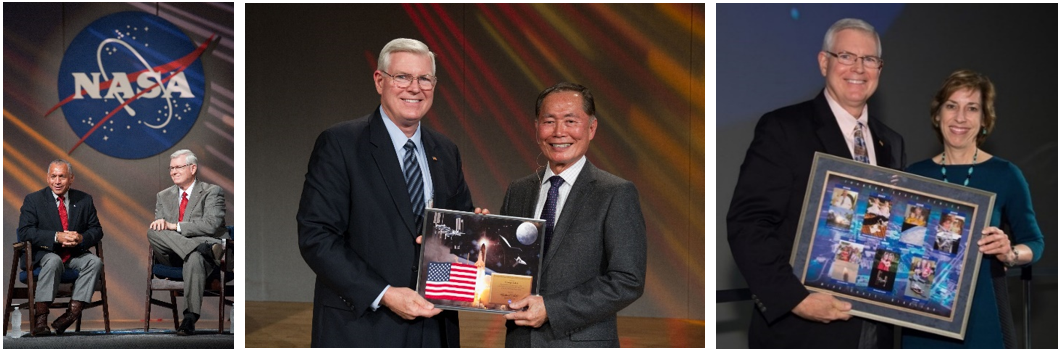
Left: In September 2011, NASA Administrator Charles F. Bolden, left, and director of NASA’s Johnson Space Center Michael L. Coats address employees. Middle: Coats presents a NASA photo montage to “Star Trek” franchise actor George Takei during his May 2012 visit to Johnson. Right: At his retirement party in January 2013, Coats receives a collage from new Johnson Director Ellen L. Ochoa. Credits: NASA
As a center director, Coats encouraged employees to maintain a good work-life balance. As one example of his people-oriented management style, on every employee’s birthday, Coats sent them a personally signed birthday card. He nurtured the philosophy of innovation and inclusion and encouraged the establishment of the first Employee Resource Groups.
On Nov. 16, 2012, Coats announced his plan to retire from NASA at the end of the calendar year, ending a stellar 44-year career that included 20 years with NASA and seven as Johnson’s director. NASA Administrator Bolden said of Coats, “He is a true patriot and an American hero. His expertise and dedication will be sorely missed, not only at JSC but across the entire agency.”
Bolden named Deputy Center Director Ochoa to succeed Coats.
The next installment in this series will cover JSC’s 11th director, Ellen S. Ochoa, the first Hispanic and second woman to serve in that position.







